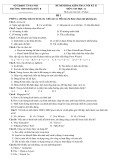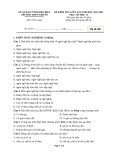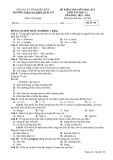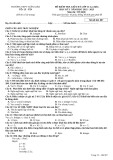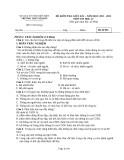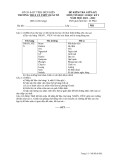Concurrency
Vu Tuyet Trinh trinhvt@it-hut.edu.vn Department of Information Systems, Faculty of Information Technology Hanoi University of Technology
Example
500USD
Account A
Account B
read(A)
If A > 500 then
B:=B+500
Crash
What happen ???
A:=A-500
2
1
Transaction
A sequence of read and write operations on data items
that logically functions as one unit of work Assuring data integrity and correction
ACID Properties
Concurrency Control
Recovery
Atomicity Consistency Isolation Durability
3
Automicity
guarantee that either all of the tasks of a transaction are
performed or none of them are
Example
crash
T: Read(A,t1); If t1 > 500 { Read(B,t2); t2:=t2+500; Write(B,t2); t1:=t1-500; Write(A,t1); }
4
2
Consistency
ensures that the DB remains in a consistent
state before the start of the transaction and after the transaction is over
Example
A+B = C
A+B = C
T: Read(A,t1); If t1 > 500 { Read(B,t2); t2:=t2+500; Write(B,t2); t1:=t1-500; Write(A,t1); }
5
Isolation
ability of the application to make operations in a
transaction appear isolated from all other operations.
Example A= 5000, B= 3000
T’: A+B (= 5000+3500)
(A+B = 4500+3500)
T: Read(A,t1); If t1 > 500 { Read(B,t2); t2:=t2+500; Write(B,t2); t1:=t1-500; Write(A,t1); }
6
3
Durability
guarantee that once the user has been notified of
success, the transaction will persist, and not be undone
Ví dụ: A= 5000, B= 3000
crash
7
T: Read(A,t1); If t1 > 500 { Read(B,t2); t2:=t2+500; Write(B,t2); t1:=t1-500; Write(A,t1); }
A= 4500, B=3500
Transaction States
8
4
Transaction Management Interfaces
Begin Trans Commit () Abort()
Savepoint Save() Rollback (savepoint) (savepoint = 0 ==> Abort)
9
Concurrency Control
Objective:
ensures that database transactions are performed concurrently
without the concurrency violating the data integrity
guarantees that no effect of committed transactions is lost, and no effect of aborted (rolled back) transactions remains in the related database.
Example
T0: read(A); T1: read(A); A := A -50; temp := A *0.1; write(A); A := A -temp; read(B); write(A); B := B + 50; read(B); write(B); B := B + temp; write(B);
10
5
Scheduling
11
(2)
(3)
(1)
Serializability
A schedule of a set of transactions is a linear ordering
of their actions
e.g. for the simultaneous deposits example:
R1(X) R2(X) W1(X) W2(X)
A serial schedule is one in which all the steps of each
transaction occur consecutively
A serializable schedule is one which is equivalent to
some serial schedule
6
Lock Definition
a synchronization mechanism for enforcing limits on
access to DB in concurrent way.
one way of enforcing concurrency control policies
Lock types
Shared lock (LS) readable but can not write Exclusive lock (LX): read and write UN(D): unlock
LS
LX
Compatibility
true
false
LS
13
false
false
LX
Example
T0: LX(A); T1: LX(A); read(A); read(A); A := A -50; temp := A *0.1; write(A); A := A -temp; LX(B); write(A) read(B); LX(B); B := B + 50; read(B); write(B); B:=B+temp; UN(A); write(B); UN(B); UN(A); UN(B);
14
7
Well-Formed, two-phased transaction
A transaction is well-formed if it acquires at least a
shared lock on Q before reading Q or an exclusive lock on Q before writing Q and doesn’t release the lock until the action is performed
Locks are also released by the end of the transaction A transaction is two-phased if it never acquires a lock
after unlocking one
i.e., there are two phases: a growing phase in which the transaction acquires locks, and a shrinking phase in which locks are released
2Phase Locking (2PL)
Phase 1
locks are acquired and no locks are released
Phase 2
locks are released and no locks are acquired
BOT
EOT
8
t Phase lock Phase unlock
Example
2PL
Not 2PL
T3 Lock(B) Read(B) Read(A) T2 Lock(B) T1 Lock(A) T4 Lock(A) B=B-50 Lock(B) Read(B) Read(A) Write(B) Read(B) Lock(A) Unlock(A) Unlock(B) B:=B+A Read(A) Lock(B) Lock(A) Write(B) Unlock(B) Read(B) Read(A) Unlock(A) A:=A+B Unlock(B) A=A+50 Unlock(B) Write(A) Pritn(A+B) Write(A) Unlock(A) Unlock(A)
Deadlock
(3)
write(A) (9)
(10)
T0: LX(B); (1) T1: LX(A); (4) read(B); (2) read(A); (5) B := B +50; temp := A *0.1; (6) write(B); (8) A := A -temp; (7) LX(A); read(A); LX(B); A := A - 50; read(B); write(A); B:=B+temp; UN(A); write(B); UN(B); UN(A); UN(B);
18
9
Resolving Deadlock
Detecting
Recovery when deadlock happen
rollback
Used waiting-graph
Avoiding
Resource ordering Timeout Wait-die Wound-wait
Waiting Graph
Graph
Node handling lock or waiting for lock Edge TU
U handle L(A) T wait to lock A T must wait until U unlock A
If there exists a cycle in the waiting graph deadlok
10
Timeout
Set a limit time for each transaction If time-out do rollback
11














